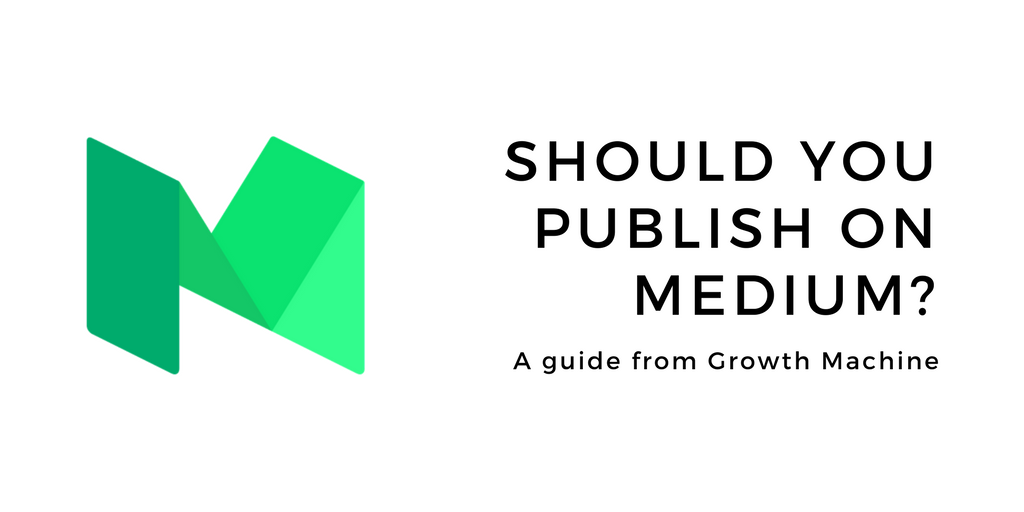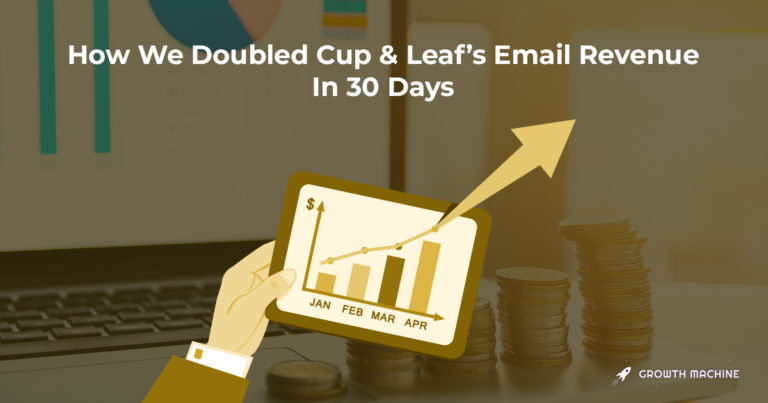Should You Publish on Medium? The Pros and Cons for Growing a Blog
Medium has become a content behemoth, picking up the reins from Blogger, WordPress.com and Tumblr as the go-to blogging platform when someone wants to start getting their content out on the internet quickly.
Because of its massive growth, many bloggers and businesses exploring content marketing build their blogs on Medium. You can get a Medium blog up and running in a few minutes, and the potential for virality through the Medium recommendation engine and “claps” mechanism makes it an alluring platform.
But when companies want to work with us to start driving more organic search traffic to their website, the first thing we tell them to do is to get their blog off of Medium ASAP.
While Medium is a great blogging platform for starting quickly, it’s terrible if you want your blog to grow, drive qualified traffic to your site, and generally be a core part of your customer acquisition strategy.
Here are the main reasons why you shouldn’t build your business’s blog on Medium. There are a few times when it does make sense to use Medium to launch your blog, though, and we’ll get to those at the end.
The Pros and Cons of Medium
This content management system has its place, especially for beginners looking to get ramped up quickly. Setting up your Medium account is easy and pricing is competitive, so why do we actively discourage our clients from publishing on Medium?
Con #1: You Don’t Own Your Content, They Do
The biggest problem with making Medium your primary blog is that you don’t own your Medium content. If the platform decides to turn off their site, delete your articles, or ban your blog, there’s nothing you can do. They can delete everything you’ve written and the audience you’ve built.
That may seem like a far-fetched, unlikely event, but when you see how Twitter, Instagram, YouTube and other social media platforms regularly shut down accounts, you don’t want to put yourself at risk of that sudden de-platforming. No matter how benign you think your content is.
Con #2: No Metadata Control
One of the most effective things you can do for your SEO is to create custom meta titles and descriptions that will capture potential readers’ attention when they see your post in Google.
But if you publish on Medium, you don’t get any control over your metadata. They’re automatically generated for you, so if you want to make your post more attractive for search results, you’re out of luck.
Con #3: The Aggregator Penalty
Google prefers sites that have a high average quality for their pages. This is why deleting deadweight pages on your site, like old or shallow content, can help quickly improve your site’s rankings.
The problem with sites like Medium is that every article published on Medium is under the “medium.com” domain, so there are hundreds of thousands, if not millions, of other pages dragging down the average value of a Medium article.
Because of this massive amount of content, it’s harder to get individual Medium pages ranked, since the per-page quality of a Medium article is deemed to be lower. This is the same reason you won’t see results from Reddit, Pinterest, Twitter and other media aggregators in the top results on Google unless there are very few good articles to show.
Con #4: No A/B Testing
If you ever want to get more advanced with your article targeting and test out different titles, descriptions, images and preview snippets, Medium won’t let you do that either. You’re stuck with what you have set as the title and what they pull as the snippet, reducing your ability to test and see what works well for getting clicks.
Why does this matter? Because even the pros don’t know what will work best for getting more click-throughs, and sometimes you have to test a few of your best ideas to see what sticks. It might not be a problem when you’re starting out, but as you grow your blog and want to get more serious about it, this can turn into a major roadblock.
Con #5: No CTA Ownership
The point of a blog for a business is to acquire customers. That doesn’t mean the writing shouldn’t be excellent and engaging, but everyone knows what the real goal is.
If you publish on Medium, you can’t add any kind of custom embedded call to action to join your newsletter or trial your product. You can have a button that links to your site, sure, but that adds an extra step that cuts down your conversion rate. If you want an email pop-up or slide-in…forget about it.
Con #6: No Tracking Pixels
Not being able to have a strong call to action in your articles wouldn’t be a big deal if you could add a tracking pixel to retarget your readers with ads…but you can’t. Medium won’t allow you to add code to track your readers and advertise to them, further devaluing any article that you publish there.
This makes sense from the point of view of their business — they don’t want tons of custom code breaking their site. But as someone trying to use their blog to generate business, it ends up hurting you.
Con #7: No Control Over Recommendations
Recommended articles are a great way to keep people reading the content on your site, and having a “read this next” recommended section at the bottom of your posts helps with SEO, dwell time, bounce rate and just about everything you care about for ranking your articles.
But…Medium doesn’t let you control what gets recommended. And most of the time, what gets recommended will be other people’s articles. So instead of your content sending readers to more of your content, it’s sending them to other writers on Medium. It’s a great strategy for Medium, not so great if you want to keep a captive audience.
Con #8: No Custom Code in General
If you want a custom contact form, share buttons, product embeds or any other fancy feature you might include in your business’s blog, you’ll run into the same problem as the tracking pixels and email pop-ups: Medium won’t allow it.
Which gives you a good heuristic: If you might want to do anything with your articles besides plug in text and pictures, then Medium is going to limit you in the long run. It just isn’t built for a business blog.
So far, I’ve been pretty hard on Medium, and like I mentioned in the beginning, I recommend against it for any business we’re working with that wants more search traffic.
So what is Medium good for?
Pro #1: Republishing
You don’t want Medium to be the primary host for your blog strategy, but that doesn’t mean you can’t republish your content there.
Medium has a built-in republishing tool, which you can access here once you create an account. All you have to do is paste in the URL of the article you want to republish on Medium, click “Import” and presto, your article will be copied over to Medium!
Republishing on Medium is helpful for a few reasons:
- You’ll get the virality elements of Medium, like claps and being in people’s home feed.
- You’ll get some clicks back to your site from the body of your article if you interlink well.
- You can put your republished post in a publication for extra exposure.
- Your main article, on your site, will be the one that ranks in Google.
You get all of the benefits of Medium with none of the downsides. Win-win.
Pro #2: Publications
The next big strength Medium has, whether you’re republishing or publishing new content, is the publications. If you can get your article published in one of the top 25 publications on the platform, you’re guaranteed to get some initial traffic to it.
This can be the initial traffic boost you need to make the difference between no readers and thousands. Medium has a strong power law dynamic, where the top one percent of articles get nearly 100 percent of the reads, and by getting your content featured in a top publication, you have a much better chance of landing it in that one percent.
Getting into a publication for the first time isn’t easy. You’ll need to find the email address of whoever manages it and reach out to pitch them on including your article. But once you get one piece published, the future ones are much easier, since you’ll have a direct line through Medium to submit your articles to the publication.
Pro #3: When You Don’t Care About SEO
It’s also possible that you don’t care about SEO or converting your blog traffic, in which case Medium probably is your best bet.
That can be more personal, less marketing-focused content. But it can also be certain company blogs like announcements, product updates or hiring pages. If you just want to get information about your company out in a lightweight way and don’t want to worry too much about turning the blog into an acquisition channel, then Medium should serve you well.
What We Recommend Instead
Medium has its place if your goal is to quickly and easily get your writing on the internet. But what if you do want your blog to work harder for you, bringing in customers from search results who have a problem that you business can solve? Then we recommend choosing one of two platforms.
WordPress.org
For most people, WordPress is going to be the way to go. Not WordPress.com, to be clear, but WordPress.org, which lets you install the open source code on your own website, and allows search engines to find your business, not your article on someone else’s site.
There is a reason that WordPress is the blogging industry standard. A WordPress blog offers the most flexibility, plugins, and functionality, and guarantees you more control over your content. And it is all hosted on your own domain.
It will let you do everything you need to do from an SEO standpoint to make sure your site is ranking well over time. Not to mention that you get to chose your custom domain name, a unique look and feel (from a ready-made or custom WordPress theme) and are afforded a range of monetization options from advertising to e-commerce plugins.
The only downside is its setup. WordPress offers full control over how your site looks, feels, and functions, which is great when you’re trying to realize a vision. But it means there will be a little more upfront work and a steeper learning curve at first, especially when it comes to their proprietary blog editor, Gutenberg.
Additionally, WordPress allows you to add tons of functionality via WordPress plugins (specialized widgets that you add to your site to perform a particular function), but you have to be careful to keep your WordPress website lean and lightweight. This is critical for SEO because Google places a high premium on site speed.
All the options and moving parts of a WordPress site mean that it can be more complicated to fix if something breaks.
But when considering WordPress vs Medium, the additional control, functionality, and ownership of your own traffic that WordPress offers makes it an easy win.
Option 2: Webflow
If you want a more plug-and-play content management system that is easier for beginners to set up and manage, but still affords you more control over your design, functionality, and traffic, then you should take a look at Webflow (which this site is built on).
You don’t completely own your content since you’re not self-hosting it, but you have lots of customization options, and almost total control over the design and function of the site. The ease of use offered by this publishing platform is unparalleled for the design and SEO benefits it offers.
Speaking of SEO, Webflow also gives you all the basic SEO functionality you need, assuming you’re somewhat familiar with the technical side of SEO management.
If you’re deciding between Medium vs WordPress, but aren’t ready to commit to learning to use WordPress, Webflow might be the right solution.
How to Decide Which Option Is Best For Your Business
Here’s the easiest way to figure out if you should or shouldn’t publish on Medium then:
If you want an easy, more personal blog, where you don’t have to worry about a hosting provider, SEO, or monetization, go with Medium.
But, if you want your blog to work for your business by bringing you qualified leads through SEO, and driving sales, publish on WordPress or Webflow and then copy your posts over to Medium using the import tool.
And if you want the SEO traffic but don’t have the bandwidth to commit to consistently publishing high quality content, then consider setting up a meeting with us to learn more about how we can help.







